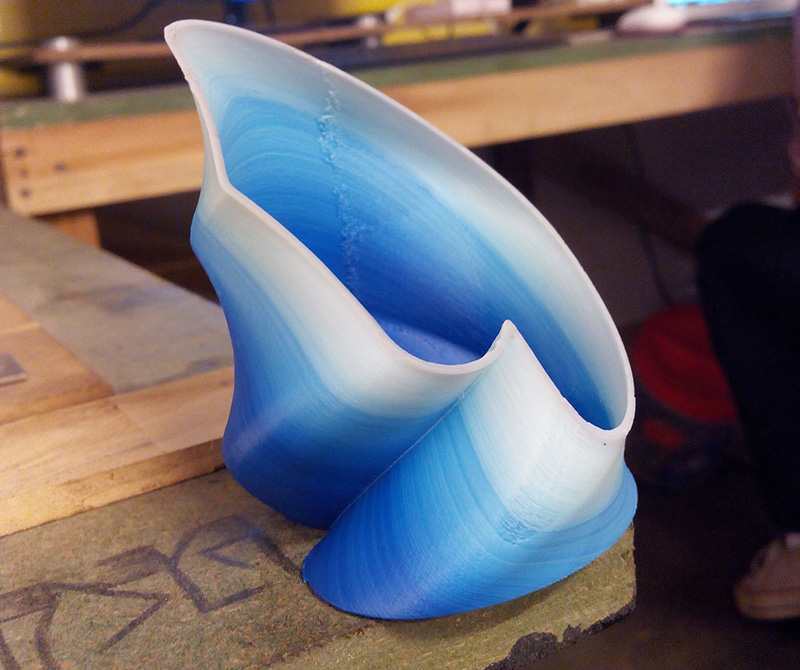A while ago, when 3D printing was the new hotness, a few people looked around and said, ‘our printers are open source, why can’t we just build the machines that make our 3D printing filament?’ There was a $40,000 prize for the first person to build an open source filament extruder, resulting in a few filament fabrication machines being released into the wild. [Rupin] over in the Mumbi hackerspace has one of these filament extruders – a Filastruder – and decided to take a look at what it could do.
The experimentations began with a few kilograms of ABS pellets he found at the market, with bags of red, blue, green, and white masterbatch pellets showing up at the Hackerspace. Experimenting with these pellets, [Rupin] was able to create some very nice looking filament that printed well and changed color over the course of a print.
There were a limitations of the process, though: the filastruder has a long melt zone, so colors will invariably mix. If you’re thinking about doing a red to blue transition with filament created on a Filastruder, you’ll end up with a filament with a little bit of red, a little bit of blue, and a lot of a weird purple color. The time to create this filament is also incredibly long; over the course of two days, [Rupin] was able to make about half a kilo of filament.
Still, the results look fantastic, and now that [Rupin] has a source for masterbatch and ABS pellets, he’s able to have a steady supply of custom color filament at the hackerspace.















OMG. So not a hack. Now in the news… Man uses red Car to drive on brown road, in Mumbai, and car gets dirt on it.
Say it isn’t so, car wash establishments are few and far between in Mumbai, so they say… the humanity…
It’s something that hackers can make use of though, an open source extruder that lets you make your own supply of ABS for a 3D printer. Means if someone knows of something made from abs which they can shred then they can recycle it into material for their printer
Interesting idea. http://www.mosaicmanufacturing.com/ seems to have a really nice setup though. I’d love to see an open sourced version of that!
The guy that won that prize was Hugh Lyman, and Filastruder is a different design from independent people. The write-up makes it sound like either Filastruder won that prize, or Filastruder was using Lyman’s design.
“the filastruder has a long melt zone, so colors will invariably mix.”
I don’t have nor know anyone with a filament extruder yet but I’m interested. Something I have noticed is that a lot of people talk about making multi-colored filament. Don’t get me wrong, I think that’s cool and I definitely want to try it some day. But, what if I want to make a single uniform color that is not available to buy. Is there a home filament making process which actually mixes all of the color so that everything is uniform and none of the original remains?
I am thinking of a situation like printing a replacement part for something. Somehow figuring out I need x parts red pelets, y parts green z parts blue. Mix it up and my new part is exactly the color of the old, everything matches. Maybe I could make something that matches the dashboard of my car that way for example.
Any filament extruder can make any color you would like (except white… you have to start with that color maybe). It is just color mixing of basic colorant pellets called master batch pellets or something like that. To my knowledge it is similar to mixing paints. For example to make a particular shade of purple you would mix in some percentage of red and blue based on weight I think. There are several filament making machines out there. There is filastruder, Lyman filament extruder, STRUdittle, Filabot, ExtrusionBot, etc…. Some are available as kits only and some are only available fully assembled. I think from your above quote you are getting a little confused. Any extruder mixes colors (if placed in the mix at the same time) I think however a longer melt zone makes the transition from one color to the next slower so there is some residual color still in the melt zone when you add your new color thereby creating some interesting transitional colors.
Ah, cool! BTW, I am not the same “Me” with the “Not a hack!” post!
Are you sure you are not the same me? B^)
In regular plastics making they just mix the plastic pellets before they put them into the hopper. So theoretically you could do the same before putting them in the extruder, but afaik there’s no “color chart” or anything like that available, you’d have to do your own experimentation.
if you can print nylon, then any colour is possible. Start with white and dye it with “Dylon” fabric dye. Then dry it in a low temp oven (say 105 degC).
And wasn’t there a recent HaD post about using a Sharpie to dye the filament?